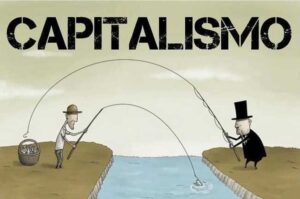The Transnational Capitalist Class. The Billionaires, the Trillionaires. “Stake Holder Capitalism” and the New World Order
CAPITALISM, 5 Feb 2024
Rick Thomas | Global Research - TRANSCEND Media Service
21 Jan 2024 – In 2011, the Great British Class Survey was conducted, in collaboration with academics from the University of Manchester, the London School of Economics, and the University of York. The British have always been obsessed with class, so it is not surprising that British academics would attempt something of this nature.
The survey polled 161,400 people, and in a fit of obviousness, they concluded,
“We demonstrate the existence of an ‘elite’, whose wealth separates them from an established middle class.”
They also concluded that class distinctions had broadened into a multitude of seven classes. This is an expansion of the Marxist model of class division of capitalists and workers that has dominated academic circles for at least a hundred years.
According to Karl Marx:
- Capitalist bourgeoisie — If you control the means of production this is you.
- Worker — Oppressed and exploited proletariat with no control of the means of production. Sells his or her labor for profit.
The survey included “unusually detailed questions based on social, cultural and economic capital.”
For the economic capital section, the survey asks how much money you make and how much money you have in the bank, plus the value of your house.
Secondly, to determine your cultural capital, it asks what kind of cultural activities you participate in. This is based on high brow culture—preference for interests such as classical music, historic architecture, museums, art galleries, jazz, theatre and French restaurants. And the other, for emergent culture—appreciation and participation in such activities as video games, social networking, sports, hanging out with friends, working out at the gym, and rap or rock concerts.
Thirdly, social capital was measured using the position generator originated by Nan Lin, an American sociologist, in 2001, which measures the range of social connections. People were asked if they knew anyone in several dozen occupations.
Seven Classes
The study found there are seven distinct classes:
- a wealthy elite
- a prosperous salaried middle class consisting of professionals and managers
- a class of technical experts
- a class of new affluent workers
- an aging traditional working class
- a ‘precariat‘ characterized by very low levels of capital and ongoing precarious economic insecurity
- a group of emergent service workers
This is an incomplete list in my humble opinion, because it fails to mention the homeless who are a separate class of non-persons, comparable to the Dalit caste in India. Homeless people have virtually no rights and squeeze out a fragile existence as urban nomads.
The most interesting group #7, the precariat, are the working poor who often fall into homelessness, when things go sideways in the economy or in their personal lives. The word precariat is a neologism of the words precarious and proletariat, coined by economist, Guy Standing, in his book, The Precariat: The New Dangerous Class.
The survey claims that the Elite class has a “mean household income of £89k (152K CDN), almost double that of the next highest class, and the average house price is £325k (556k CDN), considerably higher than any other class.” However, this elite class is only the upper middle class. The real elites make far more money than a meagre £89k per year. Many of them make that much in a day.
Other sociologists have gone further to sub-divide the wealthy into several categories:
Millionaires or High-Net-Worth Individual (HNWI) – those with $1 million or greater in investible assets. There are approximately 15 million HNWIs in the world according to the World’s Wealthiest Cities Report 2023 by Henley & Partners.
Multimillionaires or Ultra-High-Net-Worth-Individuals (UHNWI) – those with $30 million or greater net worth. There are 211,275 UHNW individuals in the world, with a total combined net worth of US$29.7 trillion.
Billionaires – According to Forbes, there are 2,640 billionaires in the world who are collectively worth about $12 trillion. The number of billionaires has been doubling every 10 years. In 2013, there were 1426 billionaires, worth $5.5 trillion. In 2003, there were 476 billionaires worth just $1.4 trillion.
TO READ FULL TEXT WITH GRAPHS AND TABLES Go to Original – globalresearch.ca
Tags: Billionaires, Capitalism, Corruption, Elites, Finance, Greed, Hunger, Inequality, New World Order, Post-capitalism, Profits, Right to Food, Super rich, Trillionaires, World Order
DISCLAIMER: The statements, views and opinions expressed in pieces republished here are solely those of the authors and do not necessarily represent those of TMS. In accordance with title 17 U.S.C. section 107, this material is distributed without profit to those who have expressed a prior interest in receiving the included information for research and educational purposes. TMS has no affiliation whatsoever with the originator of this article nor is TMS endorsed or sponsored by the originator. “GO TO ORIGINAL” links are provided as a convenience to our readers and allow for verification of authenticity. However, as originating pages are often updated by their originating host sites, the versions posted may not match the versions our readers view when clicking the “GO TO ORIGINAL” links. This site contains copyrighted material the use of which has not always been specifically authorized by the copyright owner. We are making such material available in our efforts to advance understanding of environmental, political, human rights, economic, democracy, scientific, and social justice issues, etc. We believe this constitutes a ‘fair use’ of any such copyrighted material as provided for in section 107 of the US Copyright Law. In accordance with Title 17 U.S.C. Section 107, the material on this site is distributed without profit to those who have expressed a prior interest in receiving the included information for research and educational purposes. For more information go to: http://www.law.cornell.edu/uscode/17/107.shtml. If you wish to use copyrighted material from this site for purposes of your own that go beyond ‘fair use’, you must obtain permission from the copyright owner.
